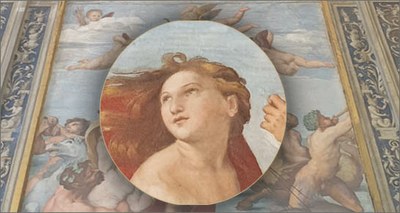Cultural heritage: ENEA part of the team which detected “Egyptian blue” in Raphael's Galatea
29/10/2020
 ENEA took part in the study conducted on Raphael's fresco "The Triumph of Galatea" at Villa Farnesina in Rome, which found evidence of "Egyptian blue”, one of the oldest non-natural pigment in the history of humanity. The outcome of a team composed of ENEA technicians, IRET-CNR, Diagnostic Laboratory for Cultural Heritage of Spoleto, XGLab-Bruker and coordinated by Antonio Sgamellotti of the Accademia Nazionale dei Lincei, the discovery is the focus of the exhibition "Raffaello at Villa Farnesina: Galatea and Psyche ” held at Villa Farnesina until 6 January 2021, as part of the celebrations for the fifth centenary of the death of the artist born in Urbino.
ENEA took part in the study conducted on Raphael's fresco "The Triumph of Galatea" at Villa Farnesina in Rome, which found evidence of "Egyptian blue”, one of the oldest non-natural pigment in the history of humanity. The outcome of a team composed of ENEA technicians, IRET-CNR, Diagnostic Laboratory for Cultural Heritage of Spoleto, XGLab-Bruker and coordinated by Antonio Sgamellotti of the Accademia Nazionale dei Lincei, the discovery is the focus of the exhibition "Raffaello at Villa Farnesina: Galatea and Psyche ” held at Villa Farnesina until 6 January 2021, as part of the celebrations for the fifth centenary of the death of the artist born in Urbino.
ENEA made available its long standing expertise on wall paintings, materials and executive techniques achieved in over thirty years of work in the field. “In the past we conducted XRF survey campaigns in point mode- i.e. by scanning the surface of the frescoes with an ad hoc system - on both the Galatea and Loggia di Psiche. In addition to these, our technicians, together with the restoration team, have re-examined the outcomes of the surveying campaign and the painting technique, noting significant differences with respect to what has been known and published so far", ENEA researcher Claudio Seccaroni of the Materials and Chemical-Physical Processes explained.
The pigment found in Raphael's fresco was the main - if not the only - blue used in classical and pre-classical antiquity and derives from the metallurgy of copper. In the Middle Ages its use declined until it disappeared, only to sporadically resume in the Renaissance. The Egyptian blue in Raphael's Galatea, the oldest work of the 1500s where it was found, could be crucial to comprehend the reasons for its resumption during the Renaissance.
"What is certain is that Raphael‘s fresco was heavily influenced by ancient Greek and Roman culture, and the experimental data shows that this concerned both style and materials of the artwork", Seccaroni said.
In over thirty years of work in cultural heritage, ENEA has developed and implemented numerous state-of-the-art technologies ranging from laser scanner systems for remote imaging -used on the Riace Bronzes- to optical fiber sensor systems for structural monitoring - applied to the Aurelian Walls in Rome and the Cathedral of Orvieto- to innovative technologies employed in restoration processes like climatic chambers for degradation studies, laser ablation for delicate cleaning and the development of protective nanocomposites, as well as tools for 3D digitization, modeling and virtual visualization and different types of scanning for archaelogical areas, excavations and finds.
For more information please contact:
Claudio Seccaroni, ENEA – Materials and Chemical-Physical Processes Laboratory, claudio.seccaroni@enea.it
